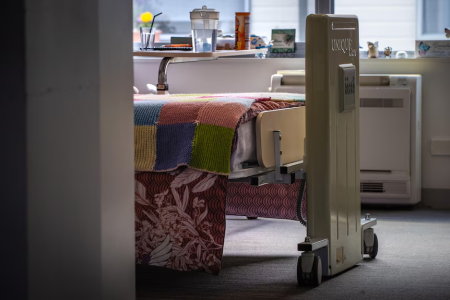‘They’re already struggling’: New changes to aged care spark fear among families
By
Maan
- Replies 85
Changes to essential support systems can bring both hope and uncertainty—especially when they affect some of society’s most vulnerable.
A looming shift in the aged care landscape is prompting concern among older Australians and their families, as questions grow about fairness, affordability, and the true cost of staying at home.
As the federal government's aged care reforms edge closer, the reality of what's coming is starting to take shape.
A major shake-up in the aged care sector was on the horizon, and while the federal government had promised improvements, many older Australians feared they were about to be left worse off.
Christina Tsobanis, who cared for her mother with Alzheimer’s, had become one of many raising concerns over the financial strain looming under the upcoming Support at Home Program.
‘We all hope to grow old and we all hope that we have the right supports around us,’ she said.
Her mother, a full pensioner, received a level 4 home care package which included 16 hours of care each week.
Christina feared that the incoming co-payment model, starting 1 July 2025, would put pressure on those like her mum who were already at their financial limit.
‘They’re already struggling. They’re already at their financial limitations and they’ve worked their whole lives, they’ve paid their taxes,’ she said.
How the new system works
The new program, which had bipartisan support, aimed to shorten wait times and increase the highest care funding from $60,000 to $78,000 annually.
It also introduced eight levels of care, replacing the current four, with payments tied to income and the type of support needed.
Clinical care—such as nursing—would remain fully funded by the government, but independence supports and everyday living tasks like gardening and cleaning would attract out-of-pocket contributions.
Who pays what?
For full pensioners, this meant a zero contribution for clinical care, 5 per cent for independence supports and 17.5 per cent for everyday living support.
Part pensioners and health card holders would pay between 5–50 per cent and 17.5–80 per cent respectively for those two categories.
Self-funded retirees would face 50 per cent and 80 per cent contributions.
For the first time, the government planned to cap service pricing via a regulator to prevent providers from overcharging.
‘No worse off’ clause not enough
Despite the introduction of a ‘no worse off’ clause for those already receiving care since September last year, Christina believed the hardship provisions were not good enough.
‘I don’t even agree with the forcing them into a position where they have to apply for the hardship policy because it’s degrading,’ she said.
‘They have worked all their lives and now they’re elderly they have to sit there and justify their existence?’
She had been attending webinars and diving into research in a bid to understand how these changes would play out.
While her mother was technically protected, Christina calculated that if they were newly entering the system, they’d be out of pocket by $200 every fortnight.
‘The cost would mean we would need to substantially reduce the services we currently receive,’ she said.
She also warned that any fee increases from providers could mean even current recipients would be forced to cut back services.
Newcomers could suffer most
Another person on a level 4 package, Sam*, also fell under the ‘no worse off’ category but criticised the reforms harshly.
‘The hardship rule cost constantly quoted is so restrictive that most will not qualify,’ they said.
‘They may as well have just announced a pension cut but that would not be as palatable. But the outcome is the same for many.’
Sam described the plan as ‘dismal, pathetic, horrific, unrealistic, a poor joke, and a very sad reflection on how society treats the elderly’.
Navigating the system already difficult
Aged care advisor Jim Moraitis said confusion and worry were widespread.
‘The overwhelming sentiment in our [community hub] is one of deep concern, anxiety and frustration,’ he said.
He explained that many current providers waived fees to stay competitive, but that would likely end under the new structure.
Mr Moraitis estimated that full pensioners receiving five to six hours of weekly support might soon pay an extra $10 to $30 per week.
‘For someone living on the full pension of about $1,100 per fortnight, even a modest co-payment could impact affordability, especially for those also managing rent, utilities and other living costs,’ he said.
He added that not all self-funded retirees had spare cash to cover the increases.
‘We may see some retirees opt out of care services altogether, which could lead to delayed support needs and greater pressure on hospitals and aged care facilities down the track,’ he said.
Not all support should cost extra, advocates say
Craig Gear from the Older Persons Advocacy Network (OPAN) acknowledged some positives in the reform.
He supported the added investment in timely home care and allied health services, as well as a new $25,000 palliative care payment.
However, he flagged concerns over what services were being classed as ‘independent support’.
‘We think showers should be considered as part of clinical care that is not a luxury,’ he said.
He also raised alarm over the lack of available pricing information so close to the rollout.
‘Some of the pricing information people are looking for, we know providers are looking for that as well,’ he said.
Assistance exists, but not without hurdles
The Department of Health and Aged Care reiterated that current recipients would not be worse off and that financial assistance would be available.
But for many, that assurance came with a tangle of fine print.
Mr Moraitis said while some families might try to avoid costs by using trusts or gifting money, the government had already tightened those loopholes.
‘If someone gives away large amounts of money or transfers assets below market value, Centrelink still counts those assets for five years when assessing aged care fees and pension eligibility,’ he said.
Family trusts, too, were under scrutiny.
‘If a person is a beneficiary or has control over a trust, the value of the trust may still be considered as part of their assessable assets, depending on how it is structured,’ he said.
He advised families to seek professional financial advice before making any decisions.
‘Anyone considering these strategies should seek financial advice from an accredited aged care specialist to avoid unexpected consequences, including impacts on pension eligibility and estate planning,’ he said.
* Name changed for privacy.
In a previous story, Australians opened up about the emotional toll of navigating the healthcare system.
Their calls for change struck a chord—especially as aged care faces similar upheaval.
Click here to learn more.

With major changes on the way, will the new aged care model truly support our older Australians—or leave them behind?
Let us know your thoughts in the comments.
A looming shift in the aged care landscape is prompting concern among older Australians and their families, as questions grow about fairness, affordability, and the true cost of staying at home.
As the federal government's aged care reforms edge closer, the reality of what's coming is starting to take shape.
A major shake-up in the aged care sector was on the horizon, and while the federal government had promised improvements, many older Australians feared they were about to be left worse off.
Christina Tsobanis, who cared for her mother with Alzheimer’s, had become one of many raising concerns over the financial strain looming under the upcoming Support at Home Program.
‘We all hope to grow old and we all hope that we have the right supports around us,’ she said.
Her mother, a full pensioner, received a level 4 home care package which included 16 hours of care each week.
Christina feared that the incoming co-payment model, starting 1 July 2025, would put pressure on those like her mum who were already at their financial limit.
‘They’re already struggling. They’re already at their financial limitations and they’ve worked their whole lives, they’ve paid their taxes,’ she said.
How the new system works
The new program, which had bipartisan support, aimed to shorten wait times and increase the highest care funding from $60,000 to $78,000 annually.
It also introduced eight levels of care, replacing the current four, with payments tied to income and the type of support needed.
Clinical care—such as nursing—would remain fully funded by the government, but independence supports and everyday living tasks like gardening and cleaning would attract out-of-pocket contributions.
Who pays what?
For full pensioners, this meant a zero contribution for clinical care, 5 per cent for independence supports and 17.5 per cent for everyday living support.
Part pensioners and health card holders would pay between 5–50 per cent and 17.5–80 per cent respectively for those two categories.
Self-funded retirees would face 50 per cent and 80 per cent contributions.
For the first time, the government planned to cap service pricing via a regulator to prevent providers from overcharging.
‘No worse off’ clause not enough
Despite the introduction of a ‘no worse off’ clause for those already receiving care since September last year, Christina believed the hardship provisions were not good enough.
‘I don’t even agree with the forcing them into a position where they have to apply for the hardship policy because it’s degrading,’ she said.
‘They have worked all their lives and now they’re elderly they have to sit there and justify their existence?’
She had been attending webinars and diving into research in a bid to understand how these changes would play out.
While her mother was technically protected, Christina calculated that if they were newly entering the system, they’d be out of pocket by $200 every fortnight.
‘The cost would mean we would need to substantially reduce the services we currently receive,’ she said.
She also warned that any fee increases from providers could mean even current recipients would be forced to cut back services.
Newcomers could suffer most
Another person on a level 4 package, Sam*, also fell under the ‘no worse off’ category but criticised the reforms harshly.
‘The hardship rule cost constantly quoted is so restrictive that most will not qualify,’ they said.
‘They may as well have just announced a pension cut but that would not be as palatable. But the outcome is the same for many.’
Sam described the plan as ‘dismal, pathetic, horrific, unrealistic, a poor joke, and a very sad reflection on how society treats the elderly’.
Navigating the system already difficult
Aged care advisor Jim Moraitis said confusion and worry were widespread.
‘The overwhelming sentiment in our [community hub] is one of deep concern, anxiety and frustration,’ he said.
He explained that many current providers waived fees to stay competitive, but that would likely end under the new structure.
Mr Moraitis estimated that full pensioners receiving five to six hours of weekly support might soon pay an extra $10 to $30 per week.
‘For someone living on the full pension of about $1,100 per fortnight, even a modest co-payment could impact affordability, especially for those also managing rent, utilities and other living costs,’ he said.
He added that not all self-funded retirees had spare cash to cover the increases.
‘We may see some retirees opt out of care services altogether, which could lead to delayed support needs and greater pressure on hospitals and aged care facilities down the track,’ he said.
Not all support should cost extra, advocates say
Craig Gear from the Older Persons Advocacy Network (OPAN) acknowledged some positives in the reform.
He supported the added investment in timely home care and allied health services, as well as a new $25,000 palliative care payment.
However, he flagged concerns over what services were being classed as ‘independent support’.
‘We think showers should be considered as part of clinical care that is not a luxury,’ he said.
He also raised alarm over the lack of available pricing information so close to the rollout.
‘Some of the pricing information people are looking for, we know providers are looking for that as well,’ he said.
Assistance exists, but not without hurdles
The Department of Health and Aged Care reiterated that current recipients would not be worse off and that financial assistance would be available.
But for many, that assurance came with a tangle of fine print.
Mr Moraitis said while some families might try to avoid costs by using trusts or gifting money, the government had already tightened those loopholes.
‘If someone gives away large amounts of money or transfers assets below market value, Centrelink still counts those assets for five years when assessing aged care fees and pension eligibility,’ he said.
Family trusts, too, were under scrutiny.
‘If a person is a beneficiary or has control over a trust, the value of the trust may still be considered as part of their assessable assets, depending on how it is structured,’ he said.
He advised families to seek professional financial advice before making any decisions.
‘Anyone considering these strategies should seek financial advice from an accredited aged care specialist to avoid unexpected consequences, including impacts on pension eligibility and estate planning,’ he said.
* Name changed for privacy.
In a previous story, Australians opened up about the emotional toll of navigating the healthcare system.
Their calls for change struck a chord—especially as aged care faces similar upheaval.
Click here to learn more.
Key Takeaways
- Aged care recipients feared new co-payments under the Support at Home Program would make services unaffordable.
- The program introduced eight care levels with fees tied to income and support type, affecting pensioners and retirees differently.
- Advocates warned that essential tasks like showering should not be classified as extra-cost ‘independent support’.
- Experts said attempts to avoid fees via trusts or gifts would likely fail due to tightened Centrelink rules.
With major changes on the way, will the new aged care model truly support our older Australians—or leave them behind?
Let us know your thoughts in the comments.








